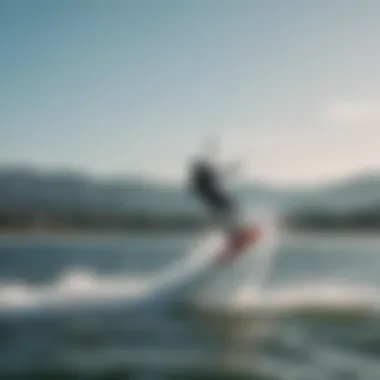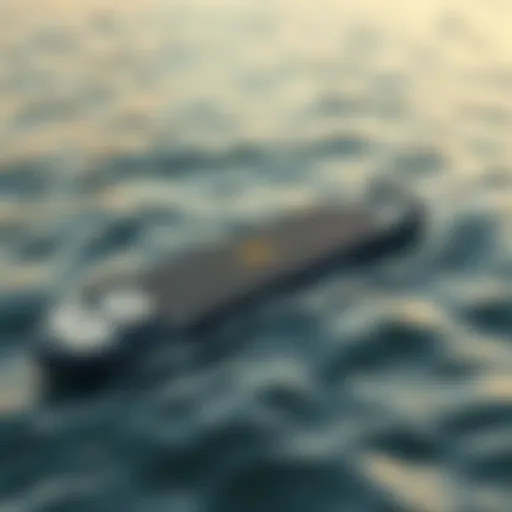The Complete Guide to Hydrofoils Available for Purchase


Intro
Hydrofoils have taken the kiteboarding world by storm, elevating the experience of many enthusiasts who thrive on the thrill of riding the waves. These advanced devices not only enhance performance but also open new avenues for exploration on the water. Understanding the nuances of hydrofoils is essential for anyone looking to elevate their kiteboarding game. From their unique construction to their influence on maneuverability and speed, hydrofoils are a fascinating blend of engineering and artistry in the realm of water sports.
In this guide, we will explore the intricate details of hydrofoils for sale, diving deep into the functionalities, various types available in the market, and essential considerations for those looking to purchase. We will navigate through an assortment of brands, their pricing, and performance aspects, ensuring that kiteboarding enthusiasts can confidently select the right gear. Maintenance tips will also be covered, providing a comprehensive understanding of how to care for these essential tools of the trade.
Next, let’s sink our teeth into the gear insights, where we’ll unearth the most important aspects of hydrofoils every kiteboarder should know, keeping our eyes peeled for the latest trends and essential tips for those just starting out.
Gear Insights
Latest Gear Reviews
When it comes to hydrofoils, keeping abreast of the latest gear reviews can turn a novice into a knowledgeable buyer. The beauty of the internet is the plethora of information available at our fingertips. Numerous sites, such as reddit.com and facebook.com, host vibrant communities where kiteboarders share their experiences, reviews, and recommendations on various hydrofoil brands and models. Check out forums to discover what seasoned riders say about the latest advancements.
Some standout brands to consider include Liquid Force, Naish, and Slingshot. These companies consistently push the boundary with innovations that cater to both performance and durability. User-generated reviews often highlight specific features such as weight, material quality, and performance in various wind conditions, allowing potential buyers to gain insights that go beyond specifications.
"As technology evolves, so does the hydrofoil industry. Keeping an eye on latest reviews may lead you to the next game-changing piece of gear."
Essential Gear for Beginners
For those just venturing into the world of hydrofoils, the right gear is paramount. It can make or break the learning experience. If you're new to kiteboarding, consider starting with beginner-friendly hydrofoils that prioritize stability over extreme performance. Look for options with a larger surface area that provide buoyancy, making it easier to learn how to ride.
Here are several essential gear suggestions for beginners:
- Hydrofoil Board: Look for wider, bigger boards to provide enough surface area.
- Foil Size: Opt for a larger foil that delivers better lift, leading to more confidence when riding.
- Kites: Choose a kite that meets beginner specifications and is suitable for your local wind conditions.
- Harness: A comfortable and supportive harness is crucial for maintaining posture and energy efficiency.
By diligently selecting your initial gear, you position yourself well for a smoother learning curve while still enjoying your time on the water.
Stay tuned as we cover techniques and tips that will further enhance your hydrofoil kiteboarding experience.
Understanding Hydrofoils
When we talk about hydrofoils, we dive into a fascinating blend of technology and water sports, where the thrill of speed meets the artistry of balance. Hydrofoils are not just another piece of equipment; they represent a significant advancement in design that allows riders to skim over water with minimal resistance. As kiteboarding enthusiasts, grasping the essence of hydrofoils is crucial—it can be the difference between a mediocre experience and one that is truly exhilarating.
Understanding what a hydrofoil does and how it works is foundational for anyone aiming to elevate their kiteboarding game. The technology harnesses the principles of fluid dynamics to enable a board to lift off the water, reducing drag and allowing for faster travel. This makes hydrofoils appealing to both beginners seeking stability and experienced riders looking for high-speed thrills.
Clearly, the importance of hydrofoils stretches beyond just their functionality; it encompasses learning the nuances of how they interact with water, how different designs affect performance, and the various components that come together to create this unique experience.
What is a Hydrofoil?
In simple terms, a hydrofoil refers to a structure, typically mounted on a kiteboard or surfboard, that lifts the vessel above the water. By reducing contact with the water surface, hydrofoils significantly lessen drag. This results in a smoother ride, particularly useful in choppy conditions. In essence, a hydrofoil looks like an underwater wing that generates lift as the board gains speed.
Hydrofoils can vary widely in shape and size, with various designs tailored for different water sports and conditions. While they usually consist of an elongated blade and a mast, configurations can differ greatly depending on intended use. For instance, surf models are often more curved and wider, best suited for wave conditions, whereas race boards tend to feature slender, narrow foils designed to maximize speed.
The Physics Behind Hydrofoils
The magic behind hydrofoils lies in the physics of lift and drag. To put it simply, when the hydrofoil moves through water at a certain speed, it generates lift due to the difference in fluid pressure on its upper and lower surfaces. This can be compared to how airplane wings work but in a more fluid environment.
- Lift Generation: As the hydrodynamic shape of a hydrofoil slices through the water, the top surface creates lower pressure while the bottom experiences higher pressure, causing the foil—and the board it’s attached to—to rise.
- Drag Reduction: With less surface area in contact with the water, drag diminishes substantially. This means riders can achieve higher speeds with less effort.
- Speed Threshold: It's important to note that the lift generated is speed-dependent. For many beginners, getting accustomed to the required speed can take some practice, but once mastered, they can enjoy a ride that feels almost weightless.
"Hydrofoils are the perfect bridge between the skill of traditional kiteboarding and the technological advancements of modern water sports."
The interplay of these physical principles not only makes hydrofoils fascinating but also emphasizes the need for careful consideration when choosing the right model. As you embark on this journey into the world of hydrofoils, having a strong grasp of these fundamentals can lead to a richer, more informed buying experience.
Furthermore, applying these concepts in practice will lead to improved performance, stability, and sheer enjoyment on the water, as you become well-acquainted with the behavior of hydrofoils.
Types of Hydrofoils Available
When diving into the world of hydrofoils, understanding the various types is pivotal. Each hydrofoil is tailored for distinct uses, whether that's leisure cruising, racing, or carving waves. This knowledge helps kiteboarding enthusiasts make informed choices that align with their personal objectives and skill levels. The importance of selecting the right type cannot be overstated—it directly influences performance, experience, and safety on the water.
Freeride Hydrofoils
Freeride hydrofoils are often seen as the most versatile option for riders. They balance speed and stability, making them suitable for a variety of conditions and riding styles. This type of hydrofoil is particularly appealing for those who enjoy exploring different environments without the pressure of competition.
- Characteristics: Freeride hydrofoils typically have a larger wing surface area, which allows for easier takeoffs and enhanced lift at lower speeds. This makes them ideal for transitioning from other water sports or for beginners.
- Benefits: The forgiving nature of freeride models helps riders gain confidence more quickly. They allow you to carry momentum through turns, which contributes to a seamless, fluid experience.
Race Hydrofoils
For those with competitive spirits, race hydrofoils are engineered to slice through the water at high speeds, focusing solely on maximized performance. These hydrofoils sacrifice some stability and ease of use for enhanced efficiency and aerodynamic design. In races, every second counts, and having the right gear can be the difference between crossing the finish line first or last.
- Characteristics: Race hydrofoils generally feature narrower wings and a sharper profile. This design minimizes drag and promotes faster speeds. They often require more skill to operate effectively, as the rider must maintain a delicate balance.
- Considerations: While thrilling, race hydrofoils may not be the best choice for beginners. They demand proficiency and an understanding of the hydrofoil's dynamics to prevent potential wipeouts.
Surf Hydrofoils
Surf hydrofoils are designed for wave riding and offer a unique experience compared to traditional surfing. They elevate the rider above the waves, providing a smooth and buoyant ride. These models can significantly transform a surfer’s experience, allowing for extended rides and achieving higher speeds over swells.
- Features: Typically, surf hydrofoils have a shorter mast and larger front wing. This setup fosters stability and maneuverability, allowing surfers to glide over waves effortlessly.
- For You: If you’re looking to combine your love for surfing with the thrill of foiling, these models open new creative avenues on the water.
Foil-Kite Models
The hybrid approach of foil-kite models caters specifically to kiteboarders who want the versatility of both disciplines. These hydrofoils allow kiteboarders to harness wind power while enjoying the lift that hydrofoiling provides. The result is a captivating blend of speed, agility, and the sheer joy of flying across the water.
- Design Manner: Foil-kite models often feature adjustable wings to fine-tune performance based on riding conditions. The adaptable structure accommodates various conditions, from light winds to high-powered sessions.
- Benefits: Riders appreciate these models for the smooth transitions they allow between powered and non-powered riding. This flexibility contributes to an exhilarating experience while still prioritizing control and safety.


"Choosing the right hydrofoil type is less about trends and more about finding what fits your riding style. The right choice can truly elevate your experience—both in performance and enjoyment."
Factors to Consider When Buying a Hydrofoil
When setting your sights on acquiring a hydrofoil, there are numerous considerations that come into play. Selecting the right hydrofoil isn’t merely about picking one that looks appealing; it’s about understanding your personal needs and how they align with the diverse options available. These considerations form the backbone of informed decision-making and directly influence your experience on the water.
Skill Level
Your skill level dramatically shapes which hydrofoil will work best for you. For novice kiteboarders, a foil with stability and ease of use is essential. Often, entry-level models are designed with larger wings and a more forgiving structure. This allows beginners to focus on mastering their technique without the added stress of complex equipment. Conversely, seasoned pros might seek out advanced models, fine-tuned for speed and agility. These foils provide more responsive handling and can bring about thrilling performances but also require a higher skill level to navigate effectively.
Intended Use
Recreational
Recreational hydrofoil users tend to prioritize fun over competition. The typical recreational foil is crafted to balance performance with ease of use. Their larger wings work wonders for generating lift at lower speeds, making them ideal for leisurely outings. This characteristic lays the groundwork for exciting and relaxed adventures on the water, allowing riders to savor the thrill without getting overly caught up in technicalities. While they may not slice through the water quite like performance models, they allow for longer sessions, as fatigue generally sets in slower when you’re cruising.
Competitive
In a competitive setting, the stakes soar. Here, every detail matters. Competitive hydrofoils are engineered for maximum efficiency, often featuring a streamlined shape that reduces drag and enhances speed. Kiteboarders who are serious about their performance usually opt for these models. Their design significantly minimizes water resistance and maximizes lift, making them suitable for intense racing situations. This, however, comes at a trade-off: they require a higher level of control and can be daunting for less experienced riders.
Freestyle
Freestyle hydrofoiling is about showcasing creativity and skill. Choosing a freestyle foil means prioritizing maneuverability over sheer speed. These foils are typically short and wide, designed for quick turns and jumps—perfect for the rider looking to impress with tricks and flips. Enthusiasts of freestyle appreciate the unique feature of these foils, allowing for maximum air time during jumps. Nevertheless, it takes time and practice to master the transition from tricks to landing smoothly.
Material and Build Quality
Build quality is another crucial consideration when buying a hydrofoil. Materials used can range from aluminum to carbon fiber, and the construction quality can significantly affect performance. A hydrofoil made of lightweight materials is generally more responsive and quicker to lift, but it might not be as durable as heavier models. On the other hand, a robust build might withstand the test of time but could add extra weight to the setup. When evaluating material, think about how you intend to use the hydrofoil over time and what environment you plan to ride in.
Wing Size and Shape
The wing size and shape play pivotal roles in how a hydrofoil performs under different conditions. Larger wings provide greater lift at slower speeds, making them ideal for beginners and recreational riders. Meanwhile, once riders gain more experience, they may favor smaller wings for quicker maneuvers and heightened performance. Each wing design has its unique advantage—whether it's for stability or agility—and finding the right fit for your riding style and environment can distinctly influence your experience.
Brands Offering Hydrofoils
When it comes to hydrofoils, the brand one chooses can make a world of difference in performance, reliability, and overall experience on the water. With the myriad of brands in the market, each offering its unique takes and features, navigating these options becomes essential for kiteboarding enthusiasts. This section aims to showcase the prominent names in the hydrofoil realm, detailing their contributions, core characteristics, and what sets them apart. The right brand can enhance not just your riding experience but also foster a deeper connection with the sport itself.
Top Hydrofoil Brands Overview
Brand A
Brand A has carved a niche for itself by focusing on innovative designs that enhance both speed and stability. One of the standout features of Brand A is its adjustable wing systems, offering users the flexibility to fine-tune their setups for various conditions. This adaptability makes it a go-to for both seasoned kiteboarders and novices. Its reputation for durability has also made Brand A a reliable choice among riders who frequently tackle challenging water conditions. That being said, some users may find their products on the pricier side compared to alternatives, yet the long-term investment proves worthwhile.
Brand B
On the other hand, Brand B stands out for its commitment to environmental sustainability. This brand uses materials sourced from recycled plastics, a feature that resonates deeply with eco-conscious bikers. Brand B’s hydrofoils are known for their lightweight build, which significantly enhances maneuverability. It's this unique combination of performance and sustainability that attracts a dedicated following. Comparatively, while some riders might feel the lighter frame sacrifices stability in rough waters, many have found that the trade-off is acceptable for the agility it provides.
Brand
Brand C leans heavily into the artistry of hydrofoil design. Known for its eye-catching aesthetics, this brand has garnered attention from various kiteboarding communities. Their hydrofoils often feature customizable skins, allowing riders to express their individuality while hitting the waves. Furthermore, Brand C emphasizes safety features, such as rounded edges on their foils to minimize risks during falls. However, it's worth noting that while their foils are visually stunning, some critics argue that performance might come second to style.
Emerging Brands to Watch
As the hydrofoil market evolves, several emerging brands are making waves with fresh ideas and innovations. Riders should keep an eye on these rising stars:
- Brand D: Focusing on affordability without compromising quality, perfect for beginners.
- Brand E: Specializing in adaptive technology, allowing users to personalize their ride performance.
- Brand F: Gaining traction for its high-tech materials that improve responsiveness and speed.
Keeping tabs on these brands may yield some of the best options as they innovate and cater to niche markets within the kiteboarding community.
Comparative Pricing of Hydrofoils
When diving into the realm of hydrofoils, pricing can be a significant factor for many. Each price point reveals not just the cost but also the quality, technology, and intended purpose of the product. Understanding comparative pricing helps kiteboarding enthusiasts make informed choices. It also demystifies the costs associated with different hydrofoils, ensuring that buyers grasp what they’re getting for their money.
The following sections break down the pricing spectrum, facilitating a better comprehension of what budget suits your desires and expectations. Whether you're starting as a beginner on a tight budget, looking to step up your game with mid-range approaches, or if you are eyeing high-end options with cutting-edge features, it’s crucial to know where your investment is going.
Budget-Friendly Options
For those who are just testing the waters or who might still be deciding if hydrofoiling is their gig, budget-friendly options exist. These hydrofoils generally range from $300 to $600. They offer decent performance without breaking the bank. Many of them are crafted from durable materials and can provide a solid introductory experience in kiteboarding.
It is wise to look for:
- Lightweight Construction: While affordable, they often utilize materials that balance cost and weight well.
- Standard Designs: Expect basic wing shapes and sizes that offer stable lift but might lack in advanced design features.
- Good Reviews: Popular brands often have starter models that are well-reviewed by users. Check the community feedback on forums like Reddit for advice and experiences.
"You get what you pay for, but you can still score some gems on the lower end of the scale."
Mid-Range Choices
If you’re past the beginner stage and ready to invest a bit more, mid-range choices might be your real sweet spot. Typically ranging from $600 to $1,200, these hydrofoils often feature enhanced technology, design, and versatile usage.
The benefits include:
- Improved Material Quality: Mid-range models often utilize better resin and construction techniques for less flex and increased durability.
- Variety in Designs: You can find hydrofoils that cater to different styles, whether you are into freeriding or have started competing.
- Performance: Often balanced between aggressive riding and casual use. Look for options with interchangeable wings as well, allowing for personalization based on your skill as you progress.
High-End Hydrofoils


For those who want nothing but the best, high-end hydrofoils will satisfy your cravings. These can range from $1,200 to $3,000 or even more, and often come with state-of-the-art technology and design improvements that can drastically change your experience on the water.
Investing in high-end hydrofoils means looking out for:
- High-Performance Materials: Carbon fiber is common here, offering light weight without compromising strength.
- Advanced Aerodynamics: Expect elaborate wing designs and customizable options that promise increased lift and maneuverability.
- Enhanced Features: Many come equipped with adjustable foils and advanced stabilizing mechanisms, giving serious kiteboarders the edge they are after.
Performance Considerations
When it comes to selecting a hydrofoil, understanding the performance considerations is essential. These factors can make or break your experience on the water, influencing everything from your speed over the waves to your ability to control the hydrofoil in various conditions. Each rider has unique preferences and skills; hence, comprehending how these considerations align with personal requirements can greatly enhance your time kiteboarding.
Speed and Maneuverability
Speed is the name of the game with hydrofoils. The thrill of skimming across the water at high velocities is pretty hard to resist. But, it’s not just about going fast; it’s also about how well you can navigate through turns and make swift adjustments while cruising.
A hydrofoil designed for speed typically has a sleeker shape and a smaller wing area. This construction reduces drag, allowing you to slice through the water like a hot knife through butter. As you gain experience, you’ll find that being able to maneuver quickly can often lead to better performance in competitive settings.
However, it’s important not to overlook the balance between speed and controllability. A too-fast hydrofoil can be challenging for beginners or even intermediate riders. Hence, before making a purchase, consider how you plan to use the hydrofoil: will you be chasing speeds or exploring more leisure-focused rides?
Stability and Control
Stability is another key feature to keep in mind. A stable hydrofoil will give you the confidence to ride through choppy water, allowing you to maintain greater control without feeling like you're on a roller coaster. Good stability minimizes the chances of erratic movements, which is especially important in gusty winds where unpredictability reigns.
Hydrofoils built for stability often possess a larger surface area and a different wing shape. Such designs lend themselves to a smoother ride, perfect for beginners learning the ropes. Experienced riders, on the other hand, might prefer a more agile setup for tricks and sharp maneuvers. Essentially, balancing stability with a level of responsiveness that suits your skills becomes a vital consideration.
"Choosing the right hydrofoil can greatly enhance your riding experience, leading to both enjoyment and performance."
Lift Characteristics
Lift characteristics are a fundamental aspect that can't be ignored when diving into the world of hydrofoils. This is, quite simply, how well the hydrofoil rises above the surface of the water when in motion. The effectiveness of lift directly affects how early a hydrofoil can take off, which is crucial for maximizing your fun.
A hydrofoil’s lift depends on several factors, including the design of the wings, their angle, and the overall weight of the rider combined with the gear. Some hydrofoils offer early lift, meaning you can harness the wind and lift off with less speed, making them user-friendly for those just taking their first steps into the sport.
For skilled riders aiming to perform jumps and tricks, understanding how lift changes with different speeds and angles can open up a whole new world of possibilities.
In summary, delving into the realm of performance considerations is akin to laying the groundwork for your kiteboarding journey. Speed, maneuverability, stability, and lift will have lasting effects on your riding experience and should align with your personal objectives and skills. Ultimately, keeping these aspects in mind will help you choose the right hydrofoil that complements your kiteboarding adventures.
Maintenance and Care for Hydrofoils
Maintaining a hydrofoil isn’t just about keeping it pretty; it’s about ensuring safety, performance, and longevity. Just like any piece of gear that meets the ocean or lake, your hydrofoil needs some TLC to function optimally. Damaged or poorly maintained equipment can lead to a rough ride and can even be dangerous. Here’s what to keep in mind to make your hydrofoil last and perform its best.
Regular Inspection
An effective way to keep your hydrofoil in top condition is to carry out regular inspections. Before hitting the water, take some time to look over your gear thoroughly. Check for any signs of wear and tear, such as small cracks in the foils or signs of corrosion on the hardware. Since hydrofoils are usually made of materials like aluminum or composites, it’s essential to catch any damage early; preventing potential issues down the line can save a lot of headaches.
- Foil Leading Edges: Inspect the leading edge for dings or cracks. Even minor damage can affect your hydrofoil’s performance.
- Screws and Bolts: Ensure all fittings are snug and secure. Loose parts make for a shaky, unsafe ride.
- Surface Condition: Look for any peeling, chipping, or discoloration, especially on painted or coated surfaces. This can be a sign of underlying issues.
Regular checks can help identify problems before they become significant, which ultimately saves money and keeps you safer.
Cleaning Techniques
Keeping your hydrofoil clean is another critical factor in maintenance. Saltwater, sand, and dirt can cause corrosion and wear over time if not properly cleaned. After each session, give your equipment a rinse to remove salt residue and foreign particles. Freshwater is your best friend here. It not only helps prevent buildup but also keeps the components smooth and functioning well.
- Use Mild Soaps: When cleaning, stick with gentle soap; harsh chemicals can damage the components’ surface. It’s a quick task—just mix with some water, scrub with a soft cloth, and rinse.
- Dry Thoroughly: After washing, make sure to dry your hydrofoil completely. Pay close attention to those tight spots where water can hide.
- Inspect After Cleaning: Cleaning time is also a perfect opportunity to spot any new damage that may not have been visible before.
By establishing a simple cleaning routine, you'll extend the life of your hydrofoil and promote better performance on the water.
Storage Recommendations
How you store your hydrofoil when it’s not in use plays a vital role in its longevity. Just like a car in a garage, your hydrofoil benefits from a clean, dry space out of harsh elements. Here are some tips on how to store your gear effectively:
- Use a Bag: Consider using a padded hydrofoil bag for extra protection during non-use periods. This keeps it safe from accidental bumps and scrapes.
- Dry Place: Store in a cool, dry area away from direct sunlight. Prolonged exposure to UV rays can degrade materials.
- Avoid Weight: Make sure to store it in a way where it isn’t under heavy objects, as constant pressure can warp your hydrofoil.
Getting into the habit of proper storage preserves the condition of your hydrofoil and ensures that it’s ready to hit the waves when you are.
The care you provide your hydrofoil today determines how well it serves you tomorrow.
In summary, maintenance and care for hydrofoils are non-negotiable factors for kiteboarding enthusiasts. Regular inspections, thorough cleaning techniques, and smart storage measures work hand in hand to keep your hydrofoil in excellent shape. This proactive approach leads to improved performance and a significantly elevated riding experience.
Safety Considerations with Hydrofoils
Engaging with hydrofoils brings a thrill that few other watersports can match, yet it also involves certain risks. Understanding safety considerations is paramount not just for enjoyment but also for minimizing the potential for accidents. Protecting oneself while indulging in kiteboarding or any hydrofoil activity ensures participants can enjoy their passion while mitigating unforeseen hazards that can arise on the water.
Wearing Appropriate Gear
You don’t climb a mountain without proper hiking shoes, right? The same goes for hydrofoiling; wearing the right gear is essential. As a kiteboarder, investing in safety equipment provides both protection and confidence. This includes items such as:
- Helmets: A good helmet can be a lifesaver, absorbing the impact in case of falls or collisions. Look for designs specifically made for kitesurfing or hydrofoiling.
- Impact Vests: These work to cushion the body against potential hits, offering additional buoyancy. If you take a tumble, they’ll add a layer of protection against the hard surfaces or sharp edges that might be lurking beneath the water’s surface.
- Wetsuits: Beyond insulation and buoyancy, wetsuits can also help prevent abrasion and even provide a degree of flotation.
In short, being appropriately dressed may not ensure you never fall, but it can mean the difference between a minor hiccup and a serious setback.
Hydrofoil Specific Risks
Hydrofoils, while fascinating and exhilarating, come with their own set of risks. Awareness here is key. Some of the more significant dangers include:


- Falling: When hydrofoils lift off the water, even small miscalculations can lead to falls. Falling can result in injuries or just a rather unceremonious splash.
- Collision Risks: In crowded waters, it's not uncommon for a kiteboarder to collide with others, whether they are on a board or simply enjoying a swim. Hydrofoils can catch people off guard due to their rapid acceleration.
- Getting Tangled: With lines and kites whipping about, losing control could lead to entanglement, making it particularly hazardous.
Addressing these risks involves paying close attention to your surroundings and communicating with nearby kiteboarders. Practicing in remote areas before hitting social spots helps hone your skills without adding undue danger.
Environmental Awareness
An often-overlooked aspect of safety is environmental awareness. Not only can it enhance your safety, but being mindful of the environment ensures we protect the settings that allow us to enjoy our sport.
- Understanding Water Conditions: Always check the local water and wind conditions. Choppy waves, strong currents, or unpredictable gusts can turn a fun outing into a challenging endeavor.
- Wildlife Protection: A sudden encounter with wildlife can lead to accidents; thus, keeping an eye out for marine animals maintains harmony with nature while protecting both you and the creatures that share the water.
- Following Local Regulations: Many areas have specific guidelines regarding hydrofoiling. Staying informed about these not only keeps you safe but also prolongs access to these beautiful recreational areas.
"A mindful kiteboarder respects the waters, acknowledging the balance between thrill-seeking and safety."
By keeping these safety considerations top of mind, hydrofoil enthusiasts can ensure their adventures are as enjoyable as they are secure. Evaluating gear, acknowledging risks, and fostering an awareness of the environment serves to create a richer and safer kiteboarding experience.
Kiteboarding with Hydrofoils
Kiteboarding with hydrofoils is increasingly becoming a popular alternative for enthusiasts looking to elevate their riding experience. It brings a unique flavor to the sport, focusing on gliding smoothly over water, instead of just powering through waves. Hydrofoils take advantage of the principles of lift and drag, allowing riders to skim the water surface, offering an exhilarating mix of speed and versatility.
The main benefits of using hydrofoils in kiteboarding are undeniable. They enable longer sessions, especially in lighter winds, where traditional boards might struggle. The ability to almost "fly" above the water not only improves speed but also reduces the impact of choppy conditions. This experience can be heavenly, especially for those used to rougher waters. Additionally, hydrofoils allow for impressive height when jumping, opening up a door of opportunities for aerial maneuvers.
However, kiteboarding with hydrofoils does come with its unique set of challenges. The learning curve can be quite steep for beginners, requiring not just a good understanding of kite control but also how to balance and manage the foil itself. Understanding how to properly trim your kite to maintain lift while foiling is essential.
In essence, kiteboarding with a hydrofoil can elevate one's entire experience on the water, but preparation and practice are key.
Techniques for Beginners
As a newbie stepping into the world of hydrofoils, some techniques can help ease the transition. It's prudent to start on a stable and larger hydrofoil, which offers more lift at lower speeds. Here are some steps to consider:
- Body Positioning: Start by maintaining a narrow stance. Keeping your weight centered will help you gain balance over the foil.
- Control the Kite: Make sure your kite is well-trimmed and steady. Focus on using small adjustments to control your speed and height.
- Take Off Slowly: Begin to generate speed gradually. As you feel comfortable, lean back slightly while pushing your heels down. This will help pop the foil out of the water.
Having patience is essential. It might feel a bit wobbly at first, so don’t fret. Many find that the awkwardness quickly dissolves as they regain control and understanding.
Advanced Tricks and Maneuvers
Once you've gotten the hang of it, the world of advanced techniques opens up, giving you the chance to impress and express creativity on the water. Here are a few tricks worth exploring:
- Jumps and Spins: Once you're airborne, you can focus on spins and grabs. The key is timing your movements with the lift generated by the foil.
- Transitions: Learning to switch directions smoothly can expand your riding style. The crucial part is to maintain a steady posture while shifting your weight.
- Wave Riding: If you're lucky enough to combine hydrofoiling with some nice swells, wave riding adds a special dynamic to kiteboarding. Here, working with the energy of the wave rather than against it can lead to some truly breathtaking experiences.
Hydrofoiling elevates your kiteboarding experience, shifting your perspective on what is possible on the water and allowing you to express yourself in ways that traditional kiteboarding cannot.
The journey to mastering kiteboarding with hydrofoils is paved with practice, precision, and a willingness to learn. As more riders discover the advantages, the sport will continue to evolve, forever changing the way we view kiteboarding. Stay committed and enjoy the ride!
User Experiences and Testimonials
When it comes to choosing hydrofoils for kiteboarding, tapping into the experiences and testimonials of fellow riders can provide valuable insights. User experiences not only give potential buyers a clear idea of how a hydrofoil performs in the real world but also highlight the nuances that might not be evident from product descriptions alone. The opinions shared by users can guide newcomers through the different brands, types, and features available in today’s market.
Case Studies of Hydrofoil Users
Diving into specific case studies of hydrofoil users exposes the variety of scenarios in which these products are utilized. For instance, take the story of Emily, a weekend kiteboarding enthusiast who transitioned from traditional boards to hydrofoils. She shared that her first hydrofoil enabled her to catch more wind and glide longer periods on the water. Her transition was not without challenges. She noted that mastering the balance took some time, but once she did, her enjoyment of the sport soared. Here’s a brief overview of her experience:
- Initial Impressions: Found the hydrofoil heavier than her standard board, which added complexity when learning.
- Performance: After a few sessions, noticed an increase in lift and speed compared to traditional kiteboarding.
- Overall Satisfaction: High; recommends hydrofoils for those willing to invest time in practice.
Another user, James, who is an avid racer, shared how using a high-end race hydrofoil transformed his competitive edge. He emphasized the importance of wing design and size, explaining how he could maintain stability even at higher speeds. His feedback included:
- Speed Gains: Achieved faster lap times after switching to the new model.
- Stability: Felt confident in rougher waters, which was a significant improvement.
- Investment Worth: Believes the investment in quality gear ultimately pays off in performance.
These narratives illustrate that individual preferences and experiences vary widely - it's about finding the right match.
Community Feedback
Community feedback often reflects broader trends and common sentiments that can be a goldmine for potential buyers. Online forums such as Reddit or dedicated Facebook groups for kiteboarding are vibrant conversation hubs, where customers share their insights about different hydrofoil brands and models. Here are some highlights from community discussions:
- Brand Reliability: Many users often note that Brand X has a solid reputation for durability, suggesting that entry-level riders opt for them.
- Wind Conditions: Discussions often revolve around the best type of hydrofoil for specific wind conditions. For example, several community members emphasize lighter models for lighter winds and vice versa.
- Solid Recommendations: You will often find suggestions pointing newcomers towards community-favorite models that have been battle-tested by members over seasons.
In building this community-focused aspect, the article not only presents real-world accounts but it also portrays the collective knowledge and support present in the kiteboarding community.
All in all, user experiences and testimonials add depth to the process of selecting a hydrofoil. Buyers not only learn what works but also understand the potential pitfalls—making the journey from novice to skilled rider much smoother.
The Future of Hydrofoils in Kiteboarding
As kiteboarding continues to evolve, the role of hydrofoils is becoming increasingly prominent. Not only do they enhance performance, but they also expand the horizons of what’s possible on the water. This topic not only sheds light on current advancements but also peeks into the exciting potential future developments, making it essential for enthusiasts and pros alike to grasp these trends.
Developments in Hydrofoil Technology
In recent years, hydrofoil technology has received substantial upgrades, shifting it from a niche aspect of kiteboarding to a central feature in many riders’ gear. From materials to design, the marking has made leaps that promise to fulfill a variety of needs while offering efficiency and safety.
Firstly, lightweight materials like carbon fiber have become the gold standard. They offer durability without the burden of excessive weight. Riders can enjoy faster speeds with less drag, allowing for a more exhilarating experience on the water.
Modular designs are also changing the game. With many brands introducing adjustable wings and mast configurations, riders have the flexibility to customize their setup based on conditions and personal preferences. This adaptability not only encourages experimentation but also creates a more engaging riding experience.
Another notable development is the refinement of lift characteristics. Manufacturers are experimenting with different shapes and sizes to optimize the lift-to-drag ratio, providing users with enhanced performance across a wider range of conditions. These innovations mean that even in lighter winds, riders can still enjoy thrilling sessions without compromise.
"Hydrofoils are not just accessories; they’re becoming indispensable tools that redefine how we interact with water and wind."
Predictions for Market Trends
Looking ahead, the market for hydrofoils in kiteboarding is anticipated to grow significantly. Factors such as increased awareness and access to information will draw newcomers, and seasoned kiteboarders wanting to upgrade their gear. Here are a few trends to consider:
- Sustainability: With more consumers advocating for eco-friendly products, brands are likely to pivot towards sustainable materials and manufacturing processes. Eco-conscious kiteboarding gear can become a key selling point.
- Smart Technology Integration: That tech-savvy wave isn’t going away! Future hydrofoils may feature integrated sensors or tech that provide riders with real-time data about performance metrics like speed, lift, and stability.
- Community Engagement: Brands might increasingly focus on community-building, leveraging online platforms – such as forums on Reddit or social media pages on Facebook – to foster a culture centered around kiteboarding and hydrofoil advancements.
- Increased Entry Models: With prices falling on some latest models, expect the market to see more affordable options that cater to beginners. This opens doors to new riders willing to dip their toes into the world of hydrofoiling without a hefty investment.















